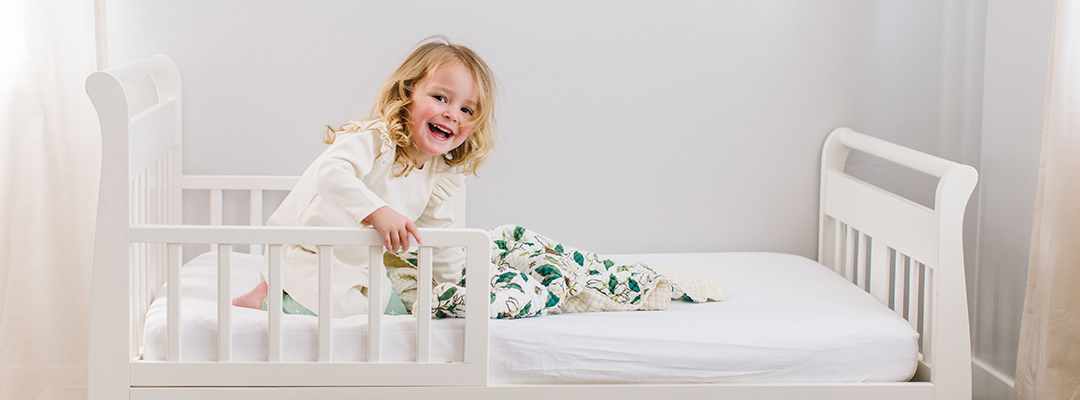We know there’s nothing you value more in this world than the chance to snuggle up with your child every chance you get… except maybe, maybe a good night’s sleep that doesn’t involve being elbowed in the face or prodded in the back by a stray superhero figurine.
Moving into separate sleeping situations can be just as scary for the parent as it is for the child; plus, it’s hard to know exactly the right age to start nudging them towards independence and the best way to go about it, since every child is different. Let’s look at when to start encouraging your toddler to sleep on their own, how to give them the safest possible sleep environment, and how to make their journey into solo sleeping a little less scary.
When should children start sleeping on their own?
I’m sure we don’t need to tell you that your little one is gloriously unique. What this means though, is that there’s no one size fits all rule for every child’s sleep development. Children can start sleeping in their own rooms as early as eighteen months old up to about three years. This entire range is considered perfectly normal.
With that in mind, most parents start looking out for hints that their child is ready around the age of two. Here are a few things to keep an eye out for:
Your child can climb out of their crib by themselves
Toddlers naturally want to explore the world, and the first thing you’ll notice is that they start pulling themselves over the wall of their crib. This can be a big safety hazard, particularly if the walls of their crib are very high; they could take a tumble and hurt themselves.
They’re getting too big for their crib
Babies should be able to stretch and move around in their cribs, and if the ends of their crib are getting too constraining, it’s going to cause them problems with their sleep. Once your child can touch the head and foot of the crib with their own head and feet, it’s time to switch over to something with more breathing room.
They’re starting to potty train
Once your child starts taking this next big step towards big kidhood, they need to be able to get up and go on their own if they need to. Keeping your potty training child in a crib can be messy (and unhealthy!) since they’re stuck in one place. Once you start this stage with their child, make sure they have the independence to move around when needed.
What kind of bed is best for a toddler?
The first thing you need to make sure of when choosing your child’s new special bed is that it’s going to keep them safe. Look for a bed with an opening where your child can get out easily, but with high sides around the rest of it to keep them from falling out while they toss and turn in their sleep. These sides are called “guardrails”.
Keeping safety in mind, you also want to check and make sure there aren’t any gaps between the mattress and the bed frame, and that there aren’t any parts sticking out. Some DIY flat pack toddler beds might have conjoining pieces of wood awkwardly protruding, and this can cause a safety risk to your child. Make sure your child’s bed is smooth, compact, and made of high-quality materials that will hold up to wear and tear without splintering.
Lastly, choose a toddler bed that rests low to the ground. This reduces the risk of injury when your sleepy baby stumbles out of bed, and makes it easier for their little legs to get out easily.
Alternatively, you could consider moving straight from their crib to a standard single bed, which they’ll be able to use throughout their childhood. Single beds (called twin beds in the US) are small enough to accommodate children from around 2-3 years old, and they’re a lot more financially feasible; because children grow so quickly, their toddler bed will only be in use for a short period of time. A single bed will be comfortable for them for another 10-15 years. If you have enough space to accommodate a single bed and your little one is on the older end of the toddler range, this might be a good option for you.
Just like a toddler bed, try to choose one with protective supports on the sides and one that isn’t too high from the ground.
Try bringing your child with you on a family shopping trip and ask them which one they would prefer. They might like the idea of a brand new grown-up bed, or they might feel more comfortable with a toddler bed. They can also help you pick out the pillows and blankets to make the transition feel less scary.
How to help your child start sleeping in their own bed
Now that you’ve picked out the perfect bed for your child, it’s time to start transitioning them to sleeping in their very own new bed. It will probably feel very strange for them at first, and even scary. You’ll want your babe to know that they are always safe in their home no matter what. Here are a few things to keep in mind when working with your child towards a new independent sleep routine.
Make bedtime an adventure
Our children pick up a lot of cues on how to behave from watching their parents. This means that if you treat their new sleeping arrangement with uncertainty, they’re going to feel it and it will make it harder for them to adjust. Instead, get excited with them! Act like getting to sleep in a bed of their very own is a big, shiny prize that you’ve both been looking forward to. Getting them cool blankets and bedding can make the switch feel even more rewarding.
Make their bedroom feel like a safe place
Obviously, you want your child’s bedroom to be hazard-free. As we saw above when looking at toddler beds, safety is paramount when choosing your child’s new sleep environment. However, children don’t recognize safety and dangers in the same way that we do, and it’s important to remember that there are other things that are important in how safe they feel going to sleep. To make your child’s bedroom feel safe, surround them with comforting colors, familiar toys, and gentle night lights. Make it a place that you could imagine curling up for a snooze in yourself.
Create a consistent bedtime routine
When helping your child transition into a big kid bed, consistency is essential. Once they begin going to bed in their own room, you need to make sure that they do it every single night. Try to put them to bed at the same time every night, and go through the same steps — brushing teeth, changing into nightclothes, switching on the night light at the same time. If they get up in the middle of the night and try to come back to bed with you, walk with them back to their room and gently put them back to bed. Make sure they understand that this is the way it is going to be from now on.
Try gradual withdrawal
It can be scary for a child to adjust to sleeping on their own, especially when they can’t see you. Gradual withdrawal means helping them adjust a little bit at a time, putting more and more distance in between you and them. For the first week, try sitting on the toddler bed with them until they fall asleep, so they feel safe knowing that you’re right beside them. Then, try sitting on a chair away from the bed and telling them you’ll be there until they’re asleep. Make sure you don’t go backwards — as we saw above, it’s important to be consistent and to keep moving towards your goal. Helping your child get to sleep on their own a little bit at a time will make the transition smoother and less frightening.
Use positive reinforcements
It’s no secret that children love rewards, and using the reward system that’s right for your child can make a huge difference in getting them to sleep on their own. Maybe that’s promising them an extra treat after breakfast, or an extra hour of movie time the next day, or stopping at the playground on the way home from school. You might also keep a bedtime calendar and give them a special sticker on each day that they go to sleep in their own beds. Every child has different things that they value and you’ll know what will get the best results from them. Think about what will make them happiest that’s also healthy (reasonably) and won’t take away from their bedtime routine.
Plan during the day — not just at bedtime
Once it’s time to actually get into bed, your child is probably pretty sleepy (and you might be starting to power down as well). Although you’ll want to reinforce the idea, it’s a good idea to sit down and talk things over with them earlier in the day, like after school. Tell them that you want them to try sleeping in a bed of their very own, and explain that you’ll be right nearby so nothing will happen to them.
Remember: this step is a partnership between you and your child, and you’ll get the best results if you find a way to go into it as a team.
Did you like it?4.3/5 (28)





